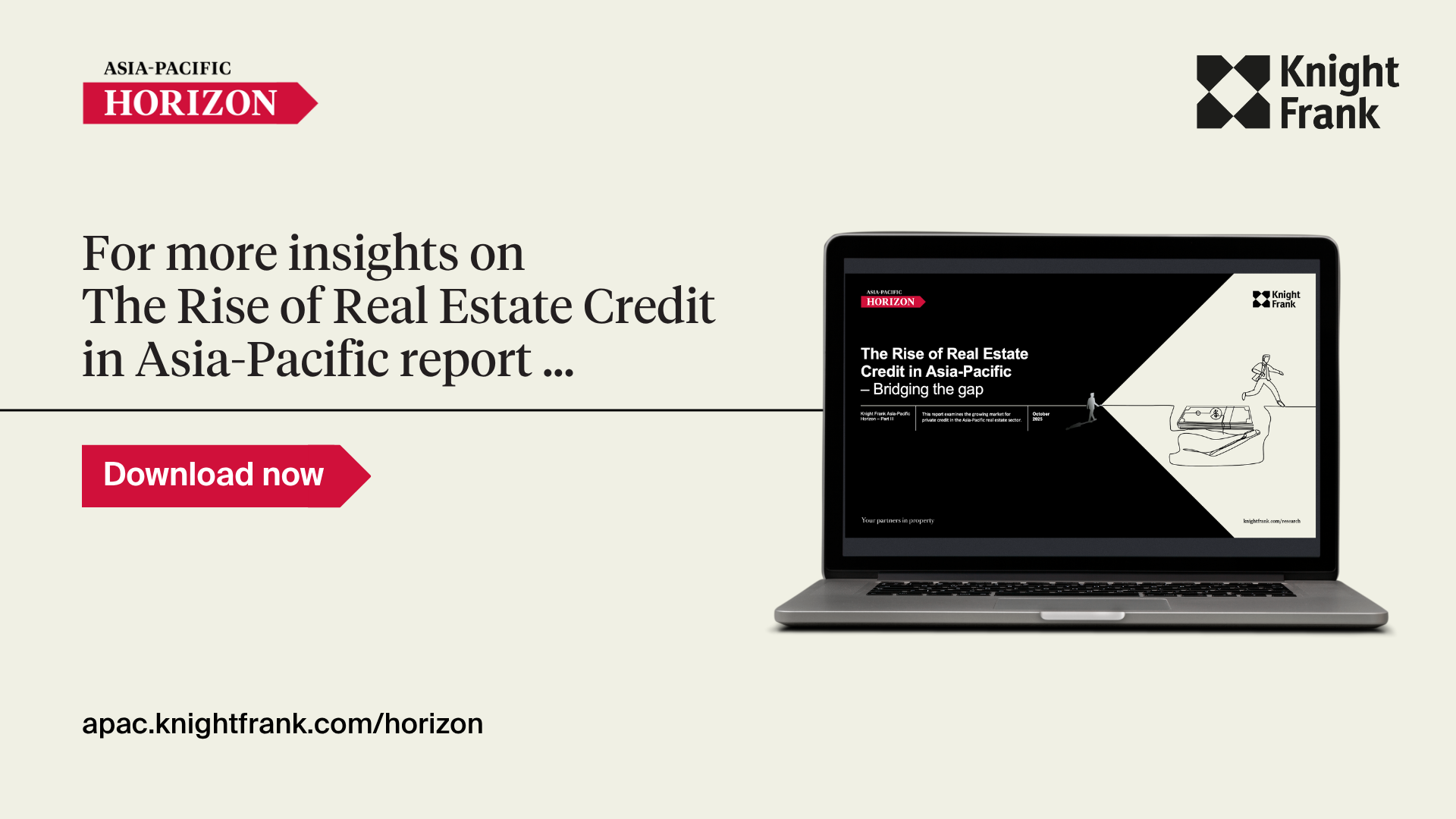Australia is expected to capture nearly half the growth across four markets, with India contributing 20-25% as institutional investors seek higher-yielding alternatives
SINGAPORE, October 2, 2025 -- Asia-Pacific real estate private credit raised US$11.2 billion between 2020 and 2024, marking a 40% increase that signals the region's growing prominence in alternative lending, according to Knight Frank's Horizon Part III: The Rise of Real Estate Credit in Asia-Pacific -- Bridging the Gap.
Over the next three years, Knight Frank projects US$90 to US$110 billion in private credit growth across Australia, Hong Kong SAR, India, and South Korea. Australia is expected to drive almost 50% of this expansion, with India contributing 20-25%, based on anticipated real estate debt growth and private credit's expanding market share through 2028.
While the region currently represents 5% of global private credit fundraising, institutional investors and family offices increasingly recognise Asia-Pacific's attractive risk-adjusted returns and diverse opportunity set, creating significant expansion potential.
Despite this under-representation, the region shows clear momentum. Average fund sizes in Asia-Pacific have consistently exceeded US$100 million since 2022, reflecting stronger capital commitments and rising real estate project funding requirements.

Report highlights:
- Australia leads regional activity, capturing 40% of the US$11.2 billion raised between 2020 and 2024. Private credit now accounts for an estimated US$50 billion or 16% of total commercial real estate lending in the country, as conservative bank policies push more borrowers toward specialist private credit funds.
- India follows with 36% of regional fundraising, driven by rapid scale-up and regulatory reforms. The country's private-credit assets under management have grown to US$17.8 billion in 2023 from just US$0.7 billion in 2010.
- South Korea accounts for 11% of the regional total, while Japan represents 5%, with the remaining 8% spread across other markets.
Simon Mathews, director, capital advisory, global capital markets, Knight Frank, says, "Private credit is becoming an increasingly prevalent financing option for developers and investors across Asia-Pacific, offering speed, flexibility, and solutions, in place of or complementing traditional lending sources. Our research shows that while banking relationships continue to anchor the market for core investments, non-bank lenders are increasing their market share for opportunistic business plans, in markets such as Australia, India, Hong Kong SAR, and South Korea."
Structural differences drive regional dynamics
Unlike Western markets, where banks face deposit shortfalls and higher regulatory costs, most developed Asia-Pacific economies operate as net savers with ample bank deposits. This fundamental difference means private credit complements rather than replaces traditional banking.
In Hong Kong SAR and South Korea, non-bank lenders are filling specific gaps left by banks retreating from risk, with family offices and institutional capital providing funding for distressed refinancing and growth-focused projects.
Family office interest accelerates growth
The report highlights increasing participation from ultra-high-net-worth individuals and family offices, with global family office assets estimated at US$3.1 trillion. Knight Frank's inaugural Family Office survey found 37% of respondents intend to increase indirect real estate exposure over the next 18 months, while BlackRock's 2025 Family Office survey shows nearly one-third want to increase private credit allocations -- the highest of any asset class.

Private credit providers target returns of 3 to 6.5% above benchmark rates in core strategies, with higher-risk approaches potentially delivering double-digit returns. The higher interest rate environment has strengthened the investment case for private credit as an asset class.
Christine Li, head of research, Asia-Pacific, Knight Frank, says, "The primary advantage of private credit over traditional funding sources is flexibility. Private credit lenders typically have a higher risk appetite, allowing greater loan-to-value ratios and requiring fewer pre-sales commitments compared to banks. This enables developers to capture higher returns as values often improve closer to project completion."
Key investment themes emerging
The report identifies several investment opportunities:
- Development financing: Private credit fills gaps left by banks that have reduced appetite for development loans due to regulatory pressures like Basel III, especially in Australia and other advanced APAC markets
- Bridge and refinancing solutions: Increasingly used in markets with valuation corrections or where banks are reluctant to refinance at par, notably in Hong Kong SAR and Australia
- Value-add strategies: Capital flowing into office conversions, ESG upgrades, and scenarios requiring bespoke financing where traditional loans are not easily secured
- New economy assets: Focus on emerging segments such as data centers, logistics, and build-to-rent residential, which receive private credit allocations due to strong growth profiles and complex funding requirements
Market outlook remains positive despite risks
While acknowledging risks including regulatory evolution, liquidity constraints, and concentration exposure, the research suggests private credit will continue expanding its market share across Asia-Pacific. However, growth patterns will differ from Western markets due to the region's relationship-driven banking culture and strong deposit bases.
The report positions Asia-Pacific's private credit market as entering a maturation phase. Opportunities are expected to be selective and driven by cyclical dislocations, market stress, or borrowers' needs for flexible capital solutions.
Simon adds, "With global interest rates remaining higher for longer, the case for private credit has strengthened, as debt funds continue to deliver attractive risk-adjusted returns. The last time interest rates were comparable was before the global financial crisis, positioning real estate credit to offer some of the most attractive risk-adjusted returns in over a decade."
ENDS
For more insights, please download the latest edition of Knight Frank’s Asia-Pacific Outlook series, The Rise of Real Estate Credit in Asia-Pacific - Bridging the Gap, report below.

For further information, please contact: Ahfisah Rahman, Content and PR Director, Asia-Pacific
Notes to Editors
Knight Frank LLP is the leading independent global property consultancy. Headquartered in London, the Knight Frank network has 740+ offices across more than territories and more than 27,000 people. The Group advises clients ranging from individual owners and buyers to major developers, investors, and corporate tenants. For further information about the Firm, please visit www.knightfrank.com.





